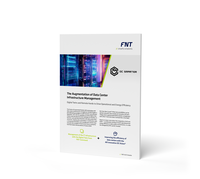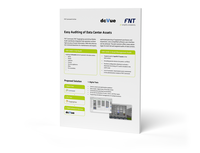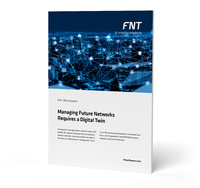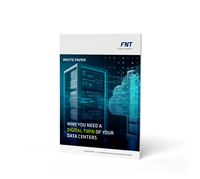Managing today’s complex data center, telecom network and IT infrastructures can be dramatically simplified with a detailed representation of all infrastructure data. A digital twin from FNT fulfills this need by recording and storing infrastructure data. It provides a highly accurate digital clone of the actual infrastructure to serve as a reliable basis for planning and decision making.
Advantages of FNT’s digital twin solution
Assess the impact of planned changes on the infrastructure before they are made. Changes to the infrastructure can be planned first with the digital twin and the results of the changes can be analyzed before any action is taken.
Perform an impact analysis of an outage by analyzing and simulating the effect on services and customers. Powerful visualizations of each individual component and its relationships support root cause analysis so you can react in a more targeted manner when faults occur and minimize business impacts. The digital twin can calculate the connections and services affected and provide results, including identifying redundant routing and which services are down.
With all data housed in a centralized platform and shared throughout the organization with other systems and applications, cross-department teams can easily coordinate efforts and improve teamwork.
FNT’s open APIs in combination with the highly flexible integration and reconciliation framework facilitates the sharing of data with other applications as well as the reconciliation with other data sources. This ensures that data stays current and accurate across the organization.
Enable resource optimization and energy efficiency to support sustainability initiatives through data-driven insights. Minimize waste, reduce environmental impact, and enhance overall operational efficiency. The Digital Twin solution enables low-effort, detailed, audit-proof documentation of Scope 3 emissions (CO2 and other) from IT, data center and network infrastructure elements, taking into account the standard requirements for Environmental Product Declarations (EPDs).
Highlights of FNT’s digital twin solution
FNT software is a resource management and planning tool that creates a complete overview of the entire system landscape and stores this information as a digital twin. FNT’s digital twin documents all physical, logical and virtual assets and resources, along with cross-silo dependencies, and merges them into a single source of truth. The result is a centralized, dynamically updating repository for documentation related to the data center, telecom network and IT infrastructure. Having a digital replica of the entire infrastructure in a single system lays the foundation for more efficient infrastructure management.
FNT’s digital twin solution automates reconciliation processes to ensure data integrity and has an extensive connectivity layer that exchanges data with third-party systems. Its easy integration with key systems streamlines processes and optimizes the use of any kind of digital infrastructure, inclusive of its connectivity and related services. It also contains many modern management functions, from analysis and schematic and geo-referenced visualization to planning and process management.
Using a digital twin makes a huge difference in your ability to provide a resilient infrastructure, optimize resource usage and scale as needed. FNT’s digital twins are used in key areas throughout an organization:
- Data Centers, to simulate and optimize cooling systems, power distribution, and server configurations, ensuring efficient resource allocation and minimizing downtime.
- Communications Networks, to replicate and visualize the network infrastructure to streamline and support operations, service assurance, design planning, capacity management, orchestration, and service fulfillment processes.
- IT Organizations, to model and manage IT infrastructure, predict system behavior, optimize resource allocation, and simulate changes before implementation, improving overall efficiency and reliability.
Would you like to experience the FNT solution for Digital Twin live?
FAQ: Digital Twin Software
A digital twin is a virtual replication of something. They can take many forms, but all capture and utilize data that represents something in the real world. A digital twin is synchronized with the original. Dynamic updates to reflect real world changes are a critical and distinguishing feature of a digital twin, as a copy only has value if it is an exact duplication.
The objective of a digital twin is to understand the state of the object that it replicates, respond to changes, improve business operations, and ultimately add value. Its purpose is to act as a mirror to simulate, predict and forecast the behavior of its real-world counterpart.
Unlike traditional modeling or simulation, digital twins leverage real-time data and advanced analytics to create dynamic, interactive models that closely mirror their real-world counterparts. This innovative approach enables organizations to gain deeper insights, optimize performance, and make data-driven decisions with greater accuracy and efficiency.
Digital twins offer transformative benefits across a wide range of industries and sectors. Industries such as manufacturing, healthcare, transportation, energy, and construction are leveraging digital twins to optimize operations, enhance product development, improve maintenance processes, and drive innovation. By harnessing the power of digital twins, organizations can unlock new opportunities for efficiency, productivity, and competitiveness in today's dynamic business landscape.
Telco: By creating virtual replicas of their network infrastructure, including towers, antennas, cables, and other components, Telecommunications companies can optimize network performance, improve coverage, and enhance reliability. Digital twins enable operators to simulate various scenarios, analyze real-time data, and identify potential issues, leading to proactive maintenance and reduced downtime. Additionally, digital twins facilitate capacity planning, allowing Telco operators to forecast network capacity requirements and optimize resource allocation. Overall, digital twins empower the Telco sector to enhance service quality, streamline operations, and drive innovation in a rapidly evolving industry landscape.
Data Centers: By creating a virtual replica of the entire data center environment, including physical infrastructure, IT equipment, operational status and data from sensors / devices and operational workflows, data center operators can optimize operations, enhance reliability, and improve efficiency. Digital twins enable operators to measure real-time data ensuring a high frequency of updated data and minimizing downtime. Additionally, digital twins facilitate capacity planning by forecasting resource requirements and optimizing resource allocation within the data center environment. Overall, digital twins empower data center operators to streamline operations, optimize resource utilization, and drive innovation in the management of their infrastructure.
Enterprise IT: By creating virtual replicas of their IT infrastructure, including servers, network devices, endpoints, and storage systems, organizations can optimize performance, enhance security, and improve efficiency. Digital twins enable IT teams to analyze real-time data and identify potential issues, leading to proactive maintenance and reduced downtime. Additionally, digital twins facilitate capacity planning by forecasting resource requirements and optimizing resource allocation within the IT environment. Overall, digital twins empower organizations to streamline IT operations, optimize resource utilization, and drive innovation in the management of their IT infrastructure.
Further Downloads
Would you like to know more about Digital Twin? Then you might be interested in the following:













